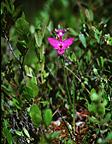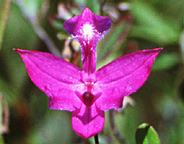Calopogon tuberosus (L.) BSP.
Grass-pink
The genus is restricted to the United States. Five species can be found
in the southeastern U.S., but only one is found north into Wisconsin. The
genus Calopogon derives it name from the Greek terms kalos
and pogon which mean, respectively, "beautiful beard" and
apparently refer to the cluster of hairs that adorn the labellum. The specific
epithet tuberosus is the Latin meaning "tuberous," in reference
to the tuberous corm of this species.


DESCRIPTION: Plant
arising from a small, oblong corm rather loosely attached to the substrate
in which is growing (typically Sphagnum). One leaf, basal,
grass-like, 10-30 cm long and 3-16 mm wide. Inflorescence a terminal
raceme of 4-12 bright magenta to pink (rarely white) flowers. Inflorescence
ranging from 10-40 cm high, each flower subtended by a lanceolate bract
4-8 mm long and about 2 mm wide; . Sepals ovate to obovate or elliptical,
1.5-2.5 cm long and 5-13 mm wide. Petals oblanceolate or elliptical,
1.5-2.5 cm long and 3-10 mm wide. Labellum uppermost (flower not
resupinate) and appearing obovate, 1-2 cm long and 6-15 mm wide; center
of the labellum bearing numerous yellow-tipped whitish hairs.
SIMILAR SPECIES: The plants are difficult to identify (or even locate)
unless flowering, but then they can be confused with little else. Two slightly
similar species that grow in similar habitat and flower at about the same
time are Arethusa bulbosaand Pogonia
ophioglossoides.
HABITAT: Calopogon can be found in two distinct habitat types
in Wisconsin. The most common habitat is acid-soiled boggy areas, typically
growing in Sphagnum. The other habitat is moist prairie. Calopogon
is rarely found today in moist prairies, primarily as result of habitat
loss.
FLOWERING DATES: June 20-August 10.
POLLINATION: Thien & Marcks (1972)
described the pollination of Calopogon tuberosus in some detail.
The brush of hairs on the lip apparently serves as a "pseudopollen"
lure, attracting naive, recently emerged bumblebees. The bees, expecting
a reward of nectar and/or pollen, land on the hairs. At this point, the
hinged labellum swings down under the weight of the bee and positions the
bee on the column, where pollen can be placed on its back. If the bee already
carries a load of pollen, it will contact the stigma and thus pollinate
the plant.
DISCUSSION: Calopogon is one of the few native North American
orchids that grows readily from seed under aseptic conditions (that is,
non-symbiotic germination). Plants also grow rapidly to flowering size.
Cyp
Haven sells cultivated plants of Calopogon. As always, it is
recommended that you buy cultivated plants from a reputable source, rather
than remove them from the wild.
WI DISTRIBUTION:  U.S. DISTRIBUTION:
U.S. DISTRIBUTION:
Go directly to Wisconsin herbarium records.
Return
to the main LIST of the Orchids of Wisconsin.
Return to the main KEY to the Orchids of
Wisconsin.


 U.S. DISTRIBUTION:
U.S. DISTRIBUTION: